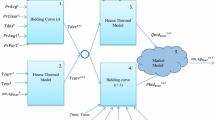Abstract
Power system simulations should be adapted to be applicable to the trends that are currently evoked by the energy transition. This transition is pushing our power system from a traditional hierarchical system to a modern interactive system. In order to keep the supply and transport of energy safe and reliant, we need to change the way we perform power system simulations. This requires a comprehensive framework in which both transmission and distribution systems are simultaneously analyzed. This chapter describes how transmission and distribution networks are modeled together as an integrated network and used to do steady-state operation analysis in order to assess the interaction of these two networks. Furthermore, we investigate the influence of the increasing amount of imbalance at distribution level on the transmission network that is evoked by the increase of highly variable resources and loads at distribution level. This influence is not taken into account in traditional power system simulations as power networks are analyzed on its own. We show that the hybrid network representation is a powerful tool to analyze modern power systems and that the effects of increased PV penetration under normal operating conditions are limited.
Access this chapter
Tax calculation will be finalised at checkout
Purchases are for personal use only
Similar content being viewed by others
References
Schavemaker P, Van der Sluis L (2008) Introduction to power system analysis. In: Electrical power system essentials, Sussex. Wiley, United Kingdom
Bhatti BA (2020) Department of electrical and computer engineering, virginia tech. In: Broadwater R, Dilek M (eds), Analyzing impact of distributed pv generation on integrated transmission & distribution system - a graph trace based approach, Energies, vol 13, no. 4526, pp 6–9
Balasubramaniam K, Abhyankar S (2017) A combined transmission and distribution system co-simulation framework for assessing the impact of volt/var control on transmission system, no. Vvc
Bollen M, Hassan F (2011) Integration of distributed generation in the power system
Yan R, Saha TK (2012) Voltage variation sensitivity analysis for unbalanced distribution networks due to photovoltaic power fluctuations. IEEE Trans Power Syst 27(2):1078–1089
Balamurugan K, Srinivasan D (2011) Review of power flow studies on distribution network with distributed generation. In: IEEE PEDS, pp 411–417
Kersting WH (2011) The whys of distribution system analysis. Requirements for a power-flow study. In: IEEE industry applications magazine, pp 59–65
Kootte ME, Sereeter B, Vuik C (2020) Solving the steady-state power flow problem on integrated transmission-distribution networks: a comparison of numerical methods. In: 2020 IEEE PES innovative smart grid technologies Europe (ISGT-Europe), pp 899–903
Schavemaker P, van der Sluis L (2008) Energy management systems. In: Electrical power system essentials, Sussex. Wiley, United Kingdom
Sereeter B, Vuik K, Witteveen C (2017) Newton power flow methods for unbalanced three-phase distribution networks. Energies 10(10):1658
Garcia PAN, Pereira JLR, Carneiro S, Da Costa VM (2000) Three-phase power flow calculations using the current injection method. IEEE Trans Power Syst 15(2):508–514
Kootte ME, Romate J, Vuik C (2011) Solving the power flow problem on integrated transmission-distribution networks: a review and numerical assessment
Taranto GN, Marinho JM (2008) A hybrid three-phase single-phase power flow formulation. IEEE Trans Power Syst 23(3):1063–1070
Sereeter B, Vuik K, Witteveen C (2017) Newton power flow methods for unbalanced three-phase distribution networks. Energies 10:1658
Bhatti BA, Broadwater R, Dilek M (2020) Analyzing impact of distributed pv generation on integrated transmission & distribution system - a graph trace based approach. Energies 13(4526):6–9
Taranto GN (2018) Simulation of integrated transmission and distribution networks with a hybrid three- phase/single-phase formulation. In: Conference proceedings
Ramachandran V, Solanki SK, Solanki J (2011) Steady State Analysis of Three Phase Unbalanced Distribution Systems with Interconnection of photovoltaic cells. In: 2011 IEEE/PES power systems conference and exposition, IEEE, pp 1–7
Eftekharnejad S, Vittal V, Heydt GT, Keel B, Loehr J (2013) Impact of increased penetration of photovoltaic generation on power systems. IEEE Trans Power Syst 28(2):893–901
SNL PV Performance modeling collaborative, “Irradiation & Insolation” (2021)
Zimmerman RD, Murillo-sánchez CE, Thomas RJ, Fellow L, Atpower AM (2011) MATPOWER: steady-state operations, systems research and education. 26(1), 12–19
Schneider KP, Mather BA, Pal BC, Ten CW, Shirek GJ, Zhu H, Fuller JC, Pereira JL, Ochoa LF, De Araujo LR, Dugan RC, Matthias S, Paudyal S, McDermott TE, Kersting W (2018) Analytic considerations and design basis for the IEEE distribution test feeders. IEEE Trans Power Syst 33(3):3181–3188
Author information
Authors and Affiliations
Corresponding author
Editor information
Editors and Affiliations
Rights and permissions
Copyright information
© 2022 The Author(s), under exclusive license to Springer Nature Singapore Pte Ltd.
About this chapter
Cite this chapter
Kootte, M., Vuik, C. (2022). The Influence of the Increasing Penetration of Photovoltaic Generation on Integrated Transmission-Distribution Power Systems. In: Tomar, A., Nguyen, P.H., Mishra, S. (eds) Control of Smart Buildings. Studies in Infrastructure and Control. Springer, Singapore. https://doi.org/10.1007/978-981-19-0375-5_2
Download citation
DOI: https://doi.org/10.1007/978-981-19-0375-5_2
Published:
Publisher Name: Springer, Singapore
Print ISBN: 978-981-19-0374-8
Online ISBN: 978-981-19-0375-5
eBook Packages: EngineeringEngineering (R0)




